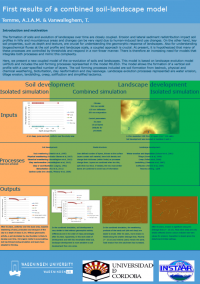CSDMS 2014 annual meeting poster Arnaud Temme
A new soil-landscape model: focus on its subsurface architecture
Tom Vanwalleghem, University of Cordoba Cordoba , Spain. tom.vanwalleghem@uco.es
Abstract:
Landscapes are shaped by the combination of (vertical) soil development dynamics and (lateral) geomorphic processes. However, almost all landscape evolution modelling studies have seen soil as a homogenous quantity: the regolith. This positions geomorphic processes as first-order determinants of landscape forms, and leaves us with questions regarding the relative importance of soil development - despite ample anecdotal evidence of soil-affected geomorphology such as in landscapes with laterite formation or clay translocation. Luckily, some soil-landscape feedbacks are increasingly being included in models of landscape evolution. Here, we present a new 'soilscape' model that combines some parts of the landscale evolution model LAPSUS with most parts of the soil development model of MILESD. Example outputs are presented, but our focus is on the subsoil architecture in the new model, where we compare various alternatives to arrive at our choice: a finite number of layers of variable thickness, variable composition and variable bulk density.
* Please acknowledge the original contributors when you are using this material. If there are any copyright issues, please let us know and we will respond as soon as possible.

